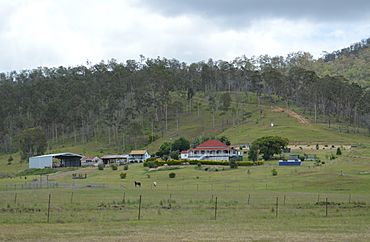Boyne Valley, Queensland facts for kids
Quick facts for kids Boyne ValleyQueensland |
|||||||||||||||
|---|---|---|---|---|---|---|---|---|---|---|---|---|---|---|---|

A homestead in the Boyne Valley, 2017
|
|||||||||||||||
| Population | 301 (2021 census) | ||||||||||||||
| • Density | 0.2543/km2 (0.659/sq mi) | ||||||||||||||
| Postcode(s) | 4680 | ||||||||||||||
| Area | 1,183.6 km2 (457.0 sq mi) | ||||||||||||||
| Time zone | AEST (UTC+10:00) | ||||||||||||||
| Location |
|
||||||||||||||
| LGA(s) | Gladstone Region | ||||||||||||||
| State electorate(s) | Callide | ||||||||||||||
| Federal Division(s) | Flynn | ||||||||||||||
|
|||||||||||||||
The Boyne Valley is a quiet, countryside area in Queensland, Australia. It's part of the Gladstone Region. This area is home to four small towns: Nagoorin, Ubobo, Builyan, and Many Peaks. In 2021, about 301 people lived in the Boyne Valley.
Contents
Where is Boyne Valley?
The Boyne Valley is located in Central Queensland. It sits in the valley of the Boyne River. It's about 500 kilometres (310 miles) north of Brisbane. It is also about 70 kilometres (43 miles) south-west of Gladstone.
Locals often call the area "The Valley." It's known as part of Gladstone's countryside. In 2008, it became part of the Gladstone Region. The area is also close to Kroombit Tops National Park, a great place for nature lovers. The main road, Gladstone–Monto Road, runs right through the valley.
A Look Back: Boyne Valley History
The Boyne Valley has an interesting past, especially with its railway.
The Old Railway Line
A railway line from Gladstone to Monto was a big deal for the valley. The first part opened on 25 July 1910. It connected Byellee to Many Peaks. Several stations were built in the Boyne Valley area:
- Wietalaba railway station
- Nagoorin railway station
- Ubobo railway station
- Hellens railway station
- Littlemore railway station
- Builyan railway station
- Many Peaks railway station
The second part of the line opened later, on 17 August 1926. This extended the railway to Barrimoon, adding Golembil railway station. The railway stopped regular services in 2002. The very last train, a special steam train, ran in 2005.
Early Schools in the Valley
Education has been important in the Boyne Valley for a long time.
- Nagoorin State School first opened its doors on 18 October 1915.
- Builyan State School welcomed students starting 4 December 1922.
- Ubobo State School began teaching on 23 March 1927.
How Many People Live Here?
The number of people living in Boyne Valley has changed over the years.
- In 2006, there were 646 people.
- By 2011, the population was 379 people.
- In 2016, it was 358 people.
- The latest count in 2021 showed 301 people living in the Boyne Valley.
Special Historic Places
The Boyne Valley has several places that are important to its history. These are called heritage-listed sites.
- The Soldier Settler House on Gladstone-Monto Road in Ubobo.
- The Norton Goldfield on Norton Road in Nagoorin.
- The Ubobo QCWA building at 5 Railway Terrace, Ubobo.
- The Ubobo Station Mistress's Residence at 7 Railway Terrace. This building is now the home of the Boyne Valley Historical Society.
Learning in the Boyne Valley
There are three primary schools in the Boyne Valley for students from Prep to Year 6.
- Ubobo State School is on Cedarvale Road. In 2017, it had 12 students. It closed temporarily in late 2019 due to low student numbers and is still closed as of July 2022.
- Builyan State School is on Gladstone Road. In 2017, it had 8 students. By February 2021, its student numbers grew to 10.
- Nagoorin State School is at 2 Ubobo Street. In 2017, it had 12 students. Its student numbers increased to 23 by February 2021.
These three schools often get together. This gives students a chance to learn and make friends with kids their own age.
There are no high schools directly in the Boyne Valley. For secondary school, students can go to Miriam Vale State School (up to Year 10). For Years 11 and 12, the closest options are Gladstone State High School, Rosedale State School, and Monto State High School.
Fun Things to Do and See
The Boyne Valley offers some cool attractions for visitors.
Rail Trail Adventure
The Dawes Range Tunnel section of the Boyne Burnett Inland Rail Trail opened on 11 September 2021. This trail is 26.28 kilometres (16.33 miles) long. It starts at Barrimoon Siding and ends at Builyan. Along the way, you'll find 6 tunnels between Barrimoon Siding and Golembil Siding. The trail also passes through the historic town of Many Peaks. Here you can see the Many Peaks Railway Complex, the Many Peaks Railway Dam, and the Many Peaks Road Bridge.
Boyne Valley Historical Cottage
If you're interested in local history, visit the Boyne Valley Historical Cottage. It was opened in 1988 by the Boyne Valley Historical Society Inc. You can see historical displays there. It's located at Railway Terrace, Ubobo, and you can visit by making an appointment.


